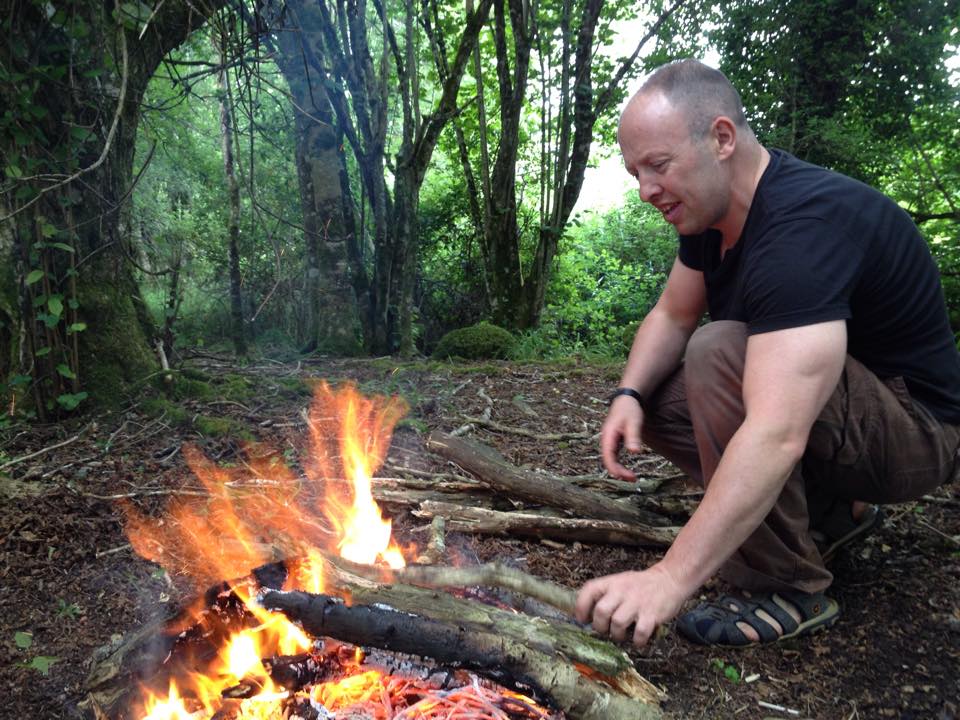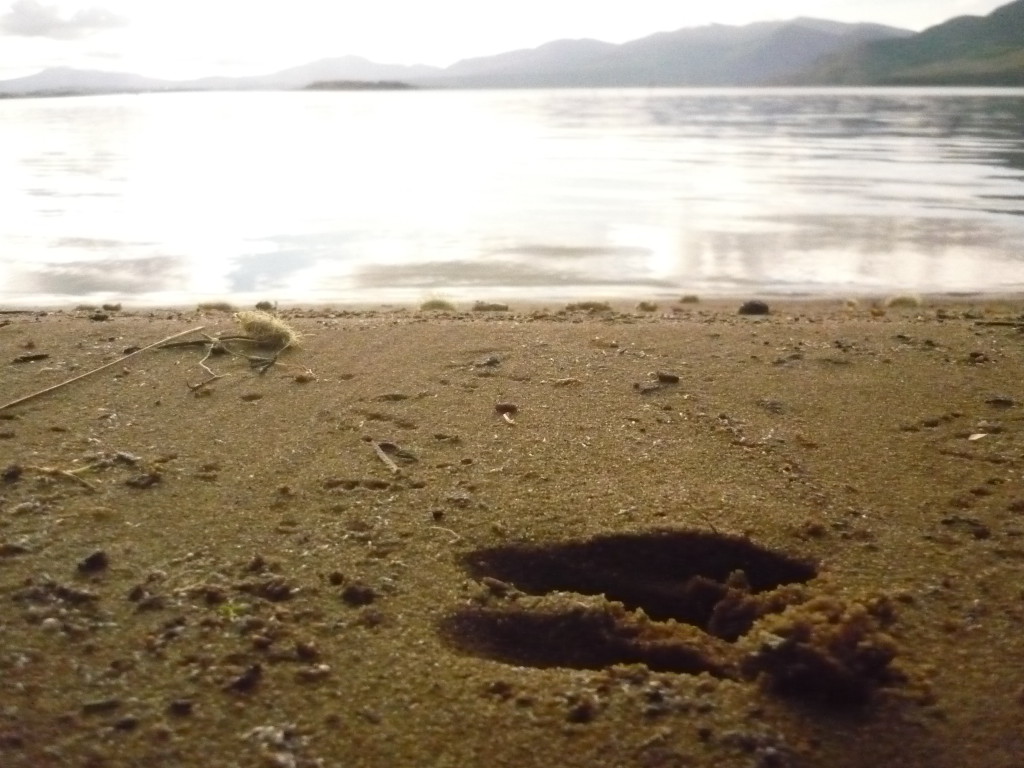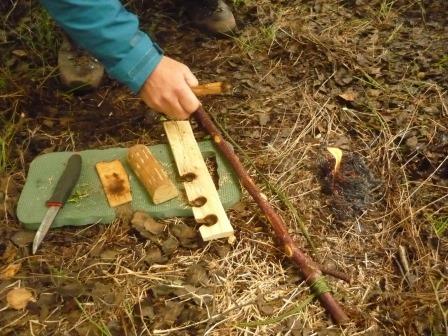By Sean Fagan

Myself, adjusting the layout of a hazel fire. In bushcraft, creating fire is a crucial skill-set and learning the bow-drill can add another fire-making method to your fire-skills repertoire. It's especially relevant for those that want to become competent in primitive (prehistoric) skills (Photo: Sean Fagan - west Ireland).
What the Bow Drill Can Teach You About Bushcraft (and Life)
. IntroductionThe bow drill is a cornerstone fire-making skill in bushcraft.
Bow-drilling demands a diligent attention to detail and technique in order to maximize success, especially in adverse conditions such as damp, cold weather.
There is a wealth of excellent instructional articles about the bow drill so you may be wondering – why have I written an article about the bow drill?
Well, for some strange reason there are mental and physical aspects to bow-drilling that is either omitted or glossed over by many bushcraft authors which is a little odd considering that the right attitude combined with a good degree of fitness along with the right skills and knowledge can all combine to greatly improve your bow-drilling success.
Also, looking at the bigger picture, the bow drill is so much more than a challenging fire-making skill; it can actually teach us quite a lot…
. 1. Patience & Self-Belief .When you first start to learn the bow drill there is a lot of technical aspects to absorb and integrate. Under the tutelage of a competent instructor your learning curve will be greatly hastened.
However, when the instructor is no longer available and you are trying to improve your bow drill skills on your own – you will, quite predictably, have what I call – good bow drill days and bad bow drill days. It's during those bad bow drill days that patience and self-belief is required to get you through.
Don't be too disheartened, because you can really learn a lot from failure. Each time you diligently practise the bow drill, you improve a little bit, sometimes you will improve a lot (even, ironically, on those occasions when you fail). They key is to try and learn something each time you try.
When you have arrived at a stage where you can confidently ignite a bow-drill fire, in all seasons, most of the time you have made great progress.
This kind of consistency takes a patient and self-believing attitude to achieve.
You need self-belief to keep going when you are not experiencing success or experiencing limited success. Eventually, with honest application, faithful adherence to technique, patience, self-learning and self-belief you will be primed for a more consistent level of success.
. 2. Attention to Detail & Concentration .There is no getting around it - the bow drill demands your full attention. Your full concentration - nothing less. From selecting your prefect bow drill wood, bow and tinder right through to blowing your first tinder bundle into glorious flame, until finally igniting a hearty campfire – the bow-drill demands your full attention every step of the way.
A lot of the time, attention to detail separates mediocre results from more consistent exceptional results.
What is great about the bow drill is that if you slack off at any time you will, most likely, not get a fire.
It’s that simple, and that’s what I love about the more demanding bushcraft skills – you need to zone your mind into the present moment regardless of what is going on in the background.
That is not only a great bushcraft skill but a great life skill – the ability to concentrate and pay full attention to every detail. The more you practise employing your full attention the better you will get at it. Just like training a muscle, which leads me nicely to my next point…
3. Physical Conditioning .The bow drill, especially on challenging days, requires a certain degree of physical fitness.
Some strength along with some cardio-vascular fitness (including anaerobic fitness) is required.
Bushcraft is a physical pastime, and the bow-drill can teach us that we need to be reasonably fit and strong. You don’t have to be herculean strong, nor do you have to participate in grueling endurance events (if that’s your thing – more power to you).
We just need a certain amount of physical robustness to cope well with the many bushcraft activities, including the bow-drill; otherwise a lack of physical robustness will be a limiting factor in how well you accomplish physical demanding tasks.
It’s disheartening, and most likely revealing, when I come across certain outdoor/bushcraft experts that are conspicuously out of shape. That’s not exactly leading by example. Conversely, a lot of great bushcraft instructors have a good cross section of physical ability. They are the ones to emulate.
By the way, watch out for a future article I will be writing about specific workouts that you can do to improve your strength and fitness for the outdoors.
.
4. Good Observational Skills .Acquiring the necessary ingredients for a bow-drill set will improve your observational skills. One of your first tasks is finding sufficient amounts of very dry, natural tinder.
You must also find the right type of dry, dead wood for your hearth and spindle with the right consistency – not too hard, not too soft and you must also acquire a handhold, a suitable lubricant and a bow that is suitably inflexible, strong, light and of the right length.
You must also prepare a camp fire ready for ignition from your tinder bundle.
That’s a lot of different materials to source from nature. Sourcing so many natural materials will inevitably sharpen your observational skills.
Sometimes observational skills are cast in the spurious category of “soft” non-physical bushcraft skills - as if the "hard" bushcraft skills such as shelter-making, fire-lighting, trapping etc. are somehow a superior skill set.
I think this is an arbitrary distinction.
Sharpening your observational skills is a hugely important, fundamental bushcraft skill that greatly compliments the physical skills of bushcraft. Keeping our powers of observation honed – makes us, for example - better navigators, more astute in selecting the right campsite, more prudent in selecting the safest line on a fast river with a canoe, and lo and behold - selecting the right bow-drill materials first time.
.

Red deer and bird tracks. Any bushcraft skill that improves your observational skills, such as tracking, is good in my books for improving your overall bushcraft skills - as so much of bushcraft is depandent on spotting, for example, resources and threats in the wild (Photo: Sean Fagan - Killarney National Park, southwest Ireland).
.
Any bushcraft skill that really improves your observational skills is a very good thing.
(Observation-dominant outdoor activities include navigation (both natural and with a compass and map), tracking, mushroom and general wild-food foraging, hunting, observing wildlife, and photography).
.
5. True Grit .Someone with a gritty attitude tries hard to gets things done regardless of circumstances and how they are feeling. Its doesn't guarantee success - but certainly improves your chances. It's important, sometimes, to have the intestinal fortitude to crack on and get the job done when everything is not rosy in the garden.
.

Sometimes, with the bow drill, applying a determined attitude can mean the difference between success or failure (photo: Sean Fagan).
.
.
Occasionally, when bow-drilling you will struggle and sometimes you will struggle a lot.
A lot of the time all that is needed is a little extra effort to get the job done. That desire to finish a challenging job well, more often than not comes from a gritty place within - an internal intangible if you will.
Grittiness will get you those unexpected wins in bow-drilling, when the odds are against you. You will never know how far you can go unless you push it to the edge. Besides, the edge is a very educational place to visit once in a while.
At least if you fail you will know it was not from a lack of effort. Removing that variable from the equation can allow an individual to focus more sharply on where he or she failed.
.
6. Realistic Expectations .Being positive is a good philosophy to embrace, partly because being negative is a sure fire way to sabotage your chances in challenging circumstances, especially when it comes to the occasionally vexing pastime of bow-drilling.
However, there is a certain glibness perpetuated by some about the bow drill - as if learning the bow drill, once initiated, is an relatively unimpeded, ascending trajectory to mastery.
It’s not, especially when you are wrestling with the bow drill on your own, which is the reality for the vast majority of bushcrafters. Diligent practise is required over a lengthy period of time.
Don’t believe me?
Watch some episodes of the program Dual Survival whereby primitive skills maestro, Cody Lundin, occasionally struggles and fails with wood-friction fire methods in realistic survival scenarios (e.g. he is often cold, wet and tired with nightfall rapidly approaching).
If a seasoned expert like Cody Lundin struggles on occasion with wood-friction fires then forgive yourself for being mortal and occasionally failing with the bow drill.
If you are succeeding a lot more than failing when it comes to the bow drill, you are making great progress.
Nature can be, at times, a tough and unpredictable taskmaster. Expecting to ignite a fire from a bow-drill in all seasons, in all weathers, (and for the extra ambitious, in multiple countries) is a daunting challenge even for the lion-hearts among us.
Relax, be patient, get a little fitter, believe in yourself, practise regularly, learn a little each time you try and you'll be fine.
Keep pushing forward, and you will crack it, perhaps sooner than you think.
To use a trite, much-overused expression - Enjoy the process. Revel in the fact that you are taking the bold step of trying to learn everything possible about an utterly fascinating, ancient fire-making skill that is the bow-drill.
That’s pretty cool when you think about it.
Time to get those embers a smokin!
.
.
Have safe & Great Adventures,
Pioneer Bushcraft.
.
.
.
Related Pioneer Bushcraft Articles:
- Bushcraft Fire-Skills: The Tinder Walk
- 4 Wilderness Safety Tips
- 3 Bushcraft uses of Balsam Fir Resin
- 7 Reasons to Camp in Winter
.
*Check me out on Instagram, Twitter & Facebook for more outdoor-related topics.
Recent Comments